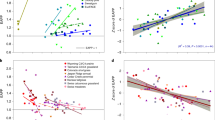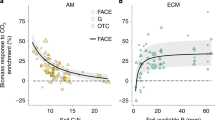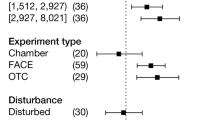Abstract
Rising atmospheric carbon dioxide concentration should stimulate biomass production directly via biochemical stimulation of carbon assimilation, and indirectly via water savings caused by increased plant water-use efficiency. Because of these water savings, the CO2 fertilization effect (CFE) should be stronger at drier sites, yet large differences among experiments in grassland biomass response to elevated CO2 appear to be unrelated to annual precipitation, preventing useful generalizations. Here, we show that, as predicted, the impact of elevated CO2 on biomass production in 19 globally distributed temperate grassland experiments reduces as mean precipitation in seasons other than spring increases, but that it rises unexpectedly as mean spring precipitation increases. Moreover, because sites with high spring precipitation also tend to have high precipitation at other times, these effects of spring and non-spring precipitation on the CO2 response offset each other, constraining the response of ecosystem productivity to rising CO2. This explains why previous analyses were unable to discern a reliable trend between site dryness and the CFE. Thus, the CFE in temperate grasslands worldwide will be constrained by their natural rainfall seasonality such that the stimulation of biomass by rising CO2 could be substantially less than anticipated.
This is a preview of subscription content, access via your institution
Access options
Access Nature and 54 other Nature Portfolio journals
Get Nature+, our best-value online-access subscription
$29.99 / 30 days
cancel any time
Subscribe to this journal
Receive 12 digital issues and online access to articles
$119.00 per year
only $9.92 per issue
Buy this article
- Purchase on Springer Link
- Instant access to full article PDF
Prices may be subject to local taxes which are calculated during checkout




Similar content being viewed by others
Data availability
All data generated or analysed during this study are included in this published article (and its Supplementary Information files) with the exception of the gridded geographic information system data, which are available from https://crudata.uea.ac.uk/cru/data/hrg/tmc/ (precipitation data) and http://glcf.umd.edu/data/landcover/data.shtml (land-cover data).
References
Schimel, D., Stephens, B. B. & Fisher, J. B. Effect of increasing CO2 on the terrestrial carbon cycle. Proc. Natl Acad. Sci. USA 112, 436–441 (2015).
Drake, B. G., GonzalezMeler, M. A. & Long, S. P. More efficient plants: a consequence of rising atmospheric CO2? Annu. Rev. Plant Physiol. Plant Mol. Biol. 48, 609–639 (1997).
Medlyn, B. E. et al. Using ecosystem experiments to improve vegetation models. Nat. Clim. Change 5, 528–534 (2015).
Kolby Smith, W. et al. Large divergence of satellite and Earth system model estimates of global terrestrial CO2 fertilization. Nat. Clim. Change 6, 306–310 (2016).
De Kauwe, M. G., Keenan, T. F., Medlyn, B. E., Prentice, I. C. & Terrer, C. Satellite based estimates underestimate the effect of CO2 fertilization on net primary productivity. Nat. Clim. Change 6, 892–893 (2016).
Morgan, J. A. et al. Water relations in grassland and desert ecosystems exposed to elevated atmospheric CO2. Oecologia 140, 11–25 (2004).
Fay, P. A. et al. Dominant plant taxa predict plant productivity responses to CO2 enrichment across precipitation and soil gradients. AoB Plants 7, plv027 (2015).
Ainsworth, E. A. & Long, S. P. What have we learned from 15 years of free-air CO2 enrichment (FACE)? A meta-analytic review of the responses of photosynthesis, canopy properties and plant production to rising CO2. New Phytol. 165, 351–372 (2005).
Lee, M., Manning, P., Rist, J., Power, S. A. & Marsh, C. A global comparison of grassland biomass responses to CO2 and nitrogen enrichment. Phil. Trans. R. Soc. Lond. B 365, 2047–2056 (2010).
Terrer, C., Vicca, S., Hungate, B. A., Phillips, R. P. & Prentice, I. C. Mycorrhizal association as a primary control of the CO2 fertilization effect. Science 353, 72–74 (2016).
Fatichi, S. et al. Partitioning direct and indirect effects reveals the response of water-limited ecosystems to elevated CO2. Proc. Natl Acad. Sci. USA 113, 12757–12762 (2016).
Leuzinger, S. & Körner, C. Rainfall distribution is the main driver of runoff under future CO2-concentration in a temperate deciduous forest. Glob. Change Biol. 16, 246–254 (2010).
Reich, P. B., Hobbie, S. E. & Lee, T. D. Plant growth enhancement by elevated CO2 eliminated by joint water and nitrogen limitation. Nat. Geosci. 7, 920–924 (2014).
Gray, S. B. et al. Intensifying drought eliminates the expected benefits of elevated carbon dioxide for soybean. Nat. Plants 2, 16132 (2016).
Hovenden, M. J., Newton, P. C. D. & Wills, K. E. Seasonal not annual rainfall determines grassland biomass response to carbon dioxide. Nature 511, 583–586 (2014).
Morgan, J. A. et al. C4 grasses prosper as carbon dioxide eliminates desiccation in warmed semi-arid grassland. Nature 476, 202–205 (2011).
Langley, J. A. & Megonigal, J. P. Ecosystem response to elevated CO2 levels limited by nitrogen-induced plant species shift. Nature 466, 96–99 (2010).
Reich, P. B. & Hobbie, S. E. Decade-long soil nitrogen constraint on the CO2 fertilization of plant biomass. Nat. Clim. Change 3, 278–282 (2013).
Lüscher, A., Daepp, M., Blum, H., Hartwig, U. A. & Nösberger, J. Fertile temperate grassland under elevated atmospheric CO2—role of feed-back mechanisms and availability of growth resources. Eur. J. Agronomy 21, 379–398 (2004).
Darenova, E., Holub, P., Krupkova, L. & Pavelka, M. Effect of repeated spring drought and summer heavy rain on managed grassland biomass production and CO2 efflux. J. Plant Ecol. 10, 476–485 (2017).
Bates, J. D., Svejcar, T., Miller, R. F. & Angell, R. A. The effects of precipitation timing on sagebrush steppe vegetation. J. Arid Environ. 64, 670–697 (2006).
Smart, A. J., Dunn, B. H., Johnson, P. S., Xu, L. & Gates, R. N. Using weather data to explain herbage yield on three great plains plant communities. Rangeland Ecol. Manage. 60, 146–153 (2007).
Epstein, H. E., Burke, I. C. & Lauenroth, W. K. Response of the shortgrass steppe to changes in rainfall seasonality. Ecosystems 2, 139–150 (1999).
Reich, P. B. et al. Species and functional group diversity independently influence biomass accumulation and its response to CO2 and N. Proc. Natl Acad. Sci. USA 101, 10101–10106 (2004).
Lüscher, A., Hendrey, G. R. & Nösberger, J. Long-term responsiveness to free air CO2 enrichment of functional types, species and genotypes of plants from fertile permanent grassland. Oecologia 113, 37–45 (1998).
Wilcox, K. R., Blair, J. M., Smith, M. D. & Knapp, A. K. Does ecosystem sensitivity to precipitation at the site-level conform to regional-scale predictions? Ecology 97, 561–568 (2016).
Averill, C., Waring, B. G. & Hawkes, C. V. Historical precipitation predictably alters the shape and magnitude of microbial functional response to soil moisture. Glob. Change Biol. 22, 1957–1964 (2016).
Tredennick, A. T., Kleinhesselink, A. R., Taylor, J. B. & Adler, P. B. Ecosystem functional response across precipitation extremes in a sagebrush steppe. PeerJ 6, e4485 (2018).
Luo, Y. et al. Progressive nitrogen limitation of ecosystem responses to rising atmospheric carbon dioxide. Bioscience 54, 731–739 (2004).
Cable, J. M. et al. Antecedent conditions influence soil respiration differences in shrub and grass patches. Ecosystems 16, 1230–1247 (2013).
Ogle, K. et al. Quantifying ecological memory in plant and ecosystem processes. Ecol. Lett. 18, 221–235 (2015).
Peltier, D. M. P., Fell, M. & Ogle, K. Legacy effects of drought in the southwestern United States: a multi-species synthesis. Ecol. Monogr. 86, 312–326 (2016).
Reynolds, J. F., Kemp, P. R., Ogle, K. & Fernandez, R. J. Modifying the ‘pulse-reserve’ paradigm for deserts of North America: precipitation pulses, soil water, and plant responses. Oecologia 141, 194–210 (2004).
Knapp, A. K. & Smith, M. D. Variation among biomes in temporal dynamics of aboveground primary production. Science 291, 481–484 (2001).
Sala, O. E., Parton, W. J., Joyce, L. A. & Lauenroth, W. K. Primary production of the central grassland region of the United States. Ecology 69, 40–45 (1988).
IPCC Climate Change 2014: Synthesis Report (eds Core Writing Team, Pachauri, R. K. & Meyer, L. A.) (IPCC, 2014).
R Development Core Team R : A Language and Environment for Statistical Computing (R Foundation for Statistical Computing, 2018).
MuMIn: Multi-Model Inference. R package version 1.15.6 (2016).
Logan, M. Biostatistical Design and Analysis Using R: A Practical Guide (Wiley-Blackwell, Chichester, 2010).
Harrell, F. E. Regression Modeling Strategies: With Applications to Linear Models, Logistic Regression and Survival Analysis (Springer, New York, 2001).
Fox, J. Effect displays in R for generalised linear models. J. Stat. Softw. 8, 1–27 (2003).
Venables, W. N. & Ripley, B. D. Modern Applied Statistics with S 4th edn (Springer, New York, 2002).
Hansen, M., DeFries, R., Townshend, J. R. G. & Sohlberg, R. Global land cover classification at 1 km resolution using a decision tree classifier. Int. J. Remote Sens. 21, 1331–1365 (2000).
Acknowledgements
We thank R. Brinkhoff for assistance with collating the data for this analysis. This research was initiated at the workshop ‘Using results from global change experiments to inform land model development and calibration’, which was co-sponsored by the US-based INTERFACE Research Coordination Network and Research Group of Global Change Ecology at Henan University (funded by MOST2013CB956300 and NSFC41030104/ D0308).
Author information
Authors and Affiliations
Contributions
S.L., J.A.L., M.J.H. and S.F. conceived the research idea and designed the study, with assistance from P.C.D.N. and K.H. M.J.H., S.L., P.C.D.N., J.A.L. and S.F. performed the analysis and, together with A.L. and P.B.R., led the writing of the manuscript. A.F. performed the mapping and all geographical analyses. P.C.D.N., M.J.H., J.A.L., L.C.A., D.M.B., N.R.C., J.S.D., J.K., A.L., P.A.N., C.B., P.B.R., S.W. and J.S. contributed unpublished data. All authors contributed to the final version of the manuscript.
Corresponding author
Ethics declarations
Competing interests
The authors declare no competing interests.
Additional information
Publisher’s note: Springer Nature remains neutral with regard to jurisdictional claims in published maps and institutional affiliations.
Supplementary information
Supplementary Information
Supplementary Figures 1–5, Supplementary Tables 1–4 and Supplementary References.
Rights and permissions
About this article
Cite this article
Hovenden, M.J., Leuzinger, S., Newton, P.C.D. et al. Globally consistent influences of seasonal precipitation limit grassland biomass response to elevated CO2. Nature Plants 5, 167–173 (2019). https://doi.org/10.1038/s41477-018-0356-x
Received:
Accepted:
Published:
Issue Date:
DOI: https://doi.org/10.1038/s41477-018-0356-x
This article is cited by
-
Shifts in vegetation activity of terrestrial ecosystems attributable to climate trends
Nature Geoscience (2023)
-
Elevated carbon dioxide concentrations increase the risk of Cd exposure in rice
Environmental Science and Pollution Research (2023)
-
Projections of future fire risk under climate change over the South African savanna
Stochastic Environmental Research and Risk Assessment (2023)
-
More labile carbon inputs lessen the positive effects of nitrogen enrichment on soil carbon storage in a temperate grassland
Plant and Soil (2023)
-
Divergent responses of plant biomass and diversity to short-term nitrogen and phosphorus addition in three types of steppe in Inner Mongolia, China
Ecological Processes (2022)



